A Palace in Bloom: The Hampton Court Flower Show
by Juliet Highet
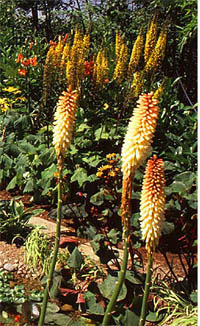 Billed as the Show of Shows and held in quite the most majestic setting imaginable -- the historic parklands of Hampton Court Palace beside the River Thames -- the Hampton Court Flower Show bids fair to rival the world-famous Chelsea Flower Show as a place of pilgrimage for anyone interested in the Great Outdoors. For that matter, there's a lot of Great Indoors, with the flowering rewards of successful gardening migrating into Victorian-style conservatories; or wooden summer houses redolent of lazy, hazy days by cricket pavilions; or there again -- the joys of the potting shed, with its rows of teetering terracotta pots, the smell of linseed oil.
Billed as the Show of Shows and held in quite the most majestic setting imaginable -- the historic parklands of Hampton Court Palace beside the River Thames -- the Hampton Court Flower Show bids fair to rival the world-famous Chelsea Flower Show as a place of pilgrimage for anyone interested in the Great Outdoors. For that matter, there's a lot of Great Indoors, with the flowering rewards of successful gardening migrating into Victorian-style conservatories; or wooden summer houses redolent of lazy, hazy days by cricket pavilions; or there again -- the joys of the potting shed, with its rows of teetering terracotta pots, the smell of linseed oil.
From the most amateur gardening enthusiast to professional media pundits, they all come flocking down to Hampton Court, about 20 miles out of central London, where deer still graze in the parklands in which Henry VIII used to hunt. For those force-fed on the pressing throngs of the Chelsea Flower Show, in which spectators peer forlornly over shoulders four-deep at the plant perfection, the concept of another bigger -- and dare one say -- better flower show, is almost sacrilege. Chelsea may have the edge in competitive excellence of exhibits. Chelsea may represent the peak of professionalism in every millimeter of highly constricted space -- but then it has the reputation of over a century's showmanship to maintain--and a very small site in which to do it. For the sheer pleasure of an exquisite day out in a spacious, rural and historic setting, the Hampton Court International Flower Show wins all the gold medals hands down.
To wander around twenty acres of open parkland amongst the best offerings of the finest growers, designers, manufacturers and suppliers, is an event not to be missed by anyone the slightest bit enthused by gardens. And always as the backdrop for the individual garden settings, or glimpsed between the four acres of marquees, is the vision of Hampton Court Palace. The present structure was built by Cardinal Wolsey in 1515, who gave it to his monarch Henry VIII. Yet even this magnificent present did not save Wolsey's skin, and he was arrested for treason, dying in the Tower of London, as of course did several of Henry's six wives. Hampton Court palace has a macabre history and is reputedly haunted by several ghosts, including two of Henry's wives and a nursemaid to his children.
Naturally, the splendid exterior of the Palace, elegantly refurbished by Wren circa 1689, gives nothing away of the dark deeds within and the Palace's own gardens must have provided many a charming shaded arbor and fragrant pathway for historic dalliance. Nowadays the fountains still cascade upwards in the center of the formal gardens, and the walled Pond Garden leading down to the river, where Wolsey and Henry used to stroll together in happier times, still has the most spectacular herbaceous borders. What an inspiration the gardens of the Palace still are.
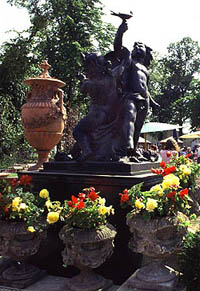 Henry VIII described Hampton Court as "more like unto a paradise than any earthly habitation" and perhaps by the time he had clocked up his sixth and last wife, Catherine Parr, the Palace was a more peaceful place. They appear to have spent many tranquil hours in the gardens with the royal children. Henry had planted a flower garden, a kitchen garden, two orchards and also what is known as the Privy Garden.
Henry VIII described Hampton Court as "more like unto a paradise than any earthly habitation" and perhaps by the time he had clocked up his sixth and last wife, Catherine Parr, the Palace was a more peaceful place. They appear to have spent many tranquil hours in the gardens with the royal children. Henry had planted a flower garden, a kitchen garden, two orchards and also what is known as the Privy Garden.
Elizabeth the 1st, Henry's second daughter, was often spotted walking briskly through the gardens on a winter morning "to catch a heat" and in summer enjoying the Knot Garden. Though this is the oldest of the Palace gardens, knot gardens really became fashionable in Elizabethan times. "Knots so enknotted it cannot be expressed" -- as the gardens were described, with their writhing and intertwining dwarf box borders, as intricate as Elizabethan poems and madrigals. The flower beds are still packed tight with herbs and flowers, old-fashioned varieties such as lavender and candytuft, pinks and sweet Williams, but they are never allowed to grow higher than the hedged box around them. Dwarf rose trees in Elizabethan times cost fourpence a hundred and weeders could be hired for threepence or fourpence a day.
Queen Elizabeth the lst liked her gardens to have running water, so there was almost certainly a fountain. She enjoyed resting in the gardens, when she was not out hunting with a long bow in the park beyond the gardens, where the Hampton Court Flower Show is now held. The Home Park was filled with all sorts of beasts of the chase, for hunting was a passion of the British Royalty, particularly of Charles the II. He laid out the Home Park, site of the Flower Show, in its present form, planting long avenues of limes radiating outwards, introduced the grand canal and filled in the Tudor moat.
Married into the House of Orange, Queen Mary wasted no time in setting up an Orangery, around 1689, and had one of the most extensive exotic plant collections in England. During the reign of George II, in 1768, the Great Vine was planted. Of the Black Hamburgh variety, it has grown to monumental proportions and produces grapes to this day. Beyond the great Fountain Garden, with its thirteen fountains, embellished with beds of box scrollwork "like lace patterns," still stand twelve splendid wrought-iron gates. Jean Tijou was commissioned to create them, to act as screens between the gardens and the park, each ten and a half feet high and over thirteen feet broad. His bill came to £2,160, 2 shillings and a farthing, a princely sum for the 17th century.
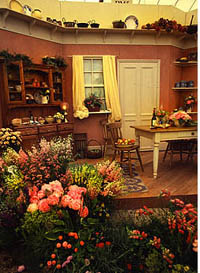 Against these exquisite gates, on the park side, musicians at the Flower Show set up appropriately period-looking little pavilions, and dressed in Tudor costume, they tootle away on flutes and lutes. Young girls, dressed in faintly historic costume -- at least they have frilled petticoats and bloomers in evidence beneath flower-colored satin dresses -- dance in front of Tijou's gates to the sounds of medieval music.
Against these exquisite gates, on the park side, musicians at the Flower Show set up appropriately period-looking little pavilions, and dressed in Tudor costume, they tootle away on flutes and lutes. Young girls, dressed in faintly historic costume -- at least they have frilled petticoats and bloomers in evidence beneath flower-colored satin dresses -- dance in front of Tijou's gates to the sounds of medieval music.
In tune with today's taste for retro architecture, many of the exhibits at both of the Flower Shows make more than a passing curtsey to nostalgia for times passed. Victorian and Edwardian conservatories dominate the landscape, while sweet old-fashioned cottage gardens rampant with endearing disorder, and replete with appropriate flowers like hollyhocks, delphiniums and pansies, signal their fragrant message -- Back to the Future. Conservation of threatened species of both garden and wild plants is big news too, and there are wild flower gardens and miniature flower-strewn meadows on display. Britain's seventeen million gardeners are being cajoled and shocked into recognition of the urgent need to conserve the plant heritage.
But it isn't all conservation. In fact, it's simply a great summer's day out. Held in July, every Hampton Court Flower Show I have attended has been blessed with sunny days. Indeed, it is usually exceedingly hot, and quite a relief to drift into one of the marques, whereas Chelsea's date being May, you are far more likely to be dashing into their marquees to escape a torrential downpour.
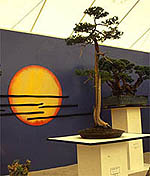 Inside these marquees are the really professional flower, plant, vegetable, shrub and tree exhibits, some of them new varieties like the sweet pea appropriately named "Hampton Court;" others well-tried favorites such as the elaborate old Bourbon roses. There are great ideas too for impoverished beginners -- aren't we all -- such as old fruit boxes cut up to create trellises. For the small garden, there are bright space-saving ideas such as ornamental-leafed salads grown amongst the flowers and companion planting of herbs like chives under roses, which help keep the pest population at bay, without the necessity for chemical sprays.
Inside these marquees are the really professional flower, plant, vegetable, shrub and tree exhibits, some of them new varieties like the sweet pea appropriately named "Hampton Court;" others well-tried favorites such as the elaborate old Bourbon roses. There are great ideas too for impoverished beginners -- aren't we all -- such as old fruit boxes cut up to create trellises. For the small garden, there are bright space-saving ideas such as ornamental-leafed salads grown amongst the flowers and companion planting of herbs like chives under roses, which help keep the pest population at bay, without the necessity for chemical sprays.
Yet flower shows are also a form of theater, an entertainment, and many of the exhibitors express delight at having the opportunity to display their products again such a backdrop -- the stage of Hampton Court Palace. Even exhibits that were quirky, contemporary or downright foreign -- certainly not heritage-Britain, looked mysteriously beautiful with the Palace as the stage set. Somehow exhibits like the giant painted garden parasols from Thailand fit in; a sculpture garden of black metal palm trees does not jar amongst the flowery femininity; and a Japanese garden complete with miniature temples and pools with carp to represent eternal life, do not seem awkward or out of place in the rich pageantry of things to see and do at the spectacular Hampton International Flower Show.
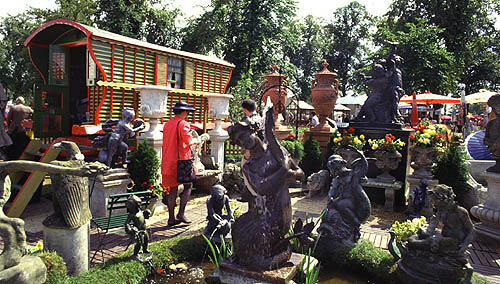 More Information:
More Information:
We regret that we no longer have the resources to maintain up-to-date links and/or hours and pricing details for the various sites and attractions listed on this website. For more information about the location(s) listed above, please use your favorite search engine or visit Wikipedia.
Juliet Highet is a freelance writer who has traveled
around the world. She writers for various UK and international
magazines.
Article and photos © 2005 Juliet Highet
|
